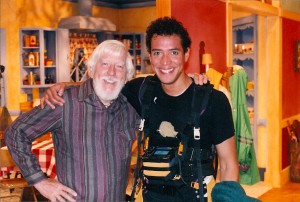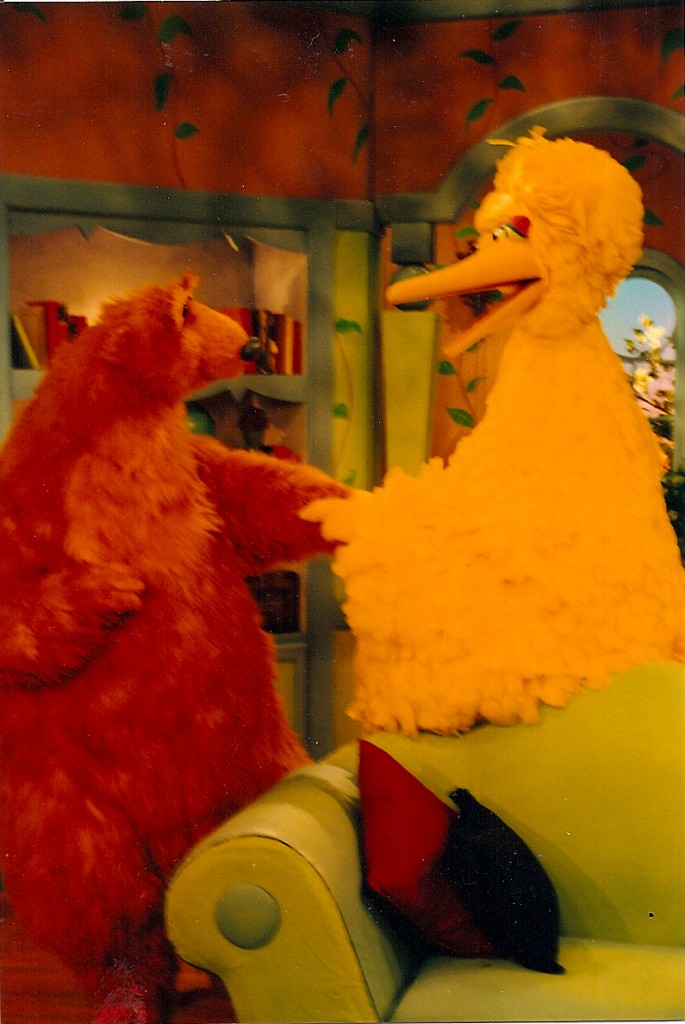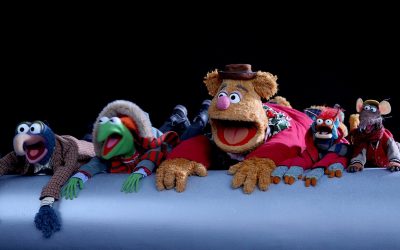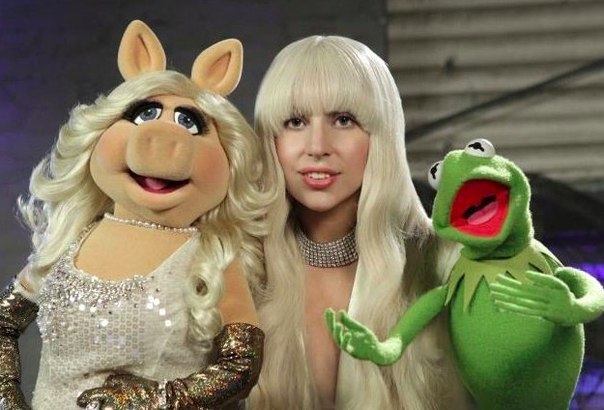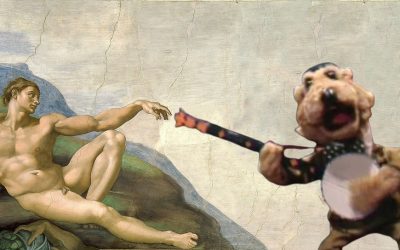Stay tuned to the end of this post for a video bonus clip of some extra Qs and As with Mr. MacNeal. And now, how about we kick off the third and final installment with some questions about Breakfast with Bear? And while we’re at it, here’s a spiffy photo from MacNeal’s personal collection, taken on the set of Bear in the Big Blue House on a day when Sesame and Bear were both taping episodes at Kaufman Astoria Studios in New York!
Tough Pigs: Speaking of your live appearances, how did the series Breakfast with Bear work?
NM: We were actually in children’s homes, in the real world, and of course every child has a different home. There was a kid whose kitchen was so small — How small was it? — It was so small that the camera was literally outside the window, shooting in, because there was no room between Bear and the kitchen table. There was a kid who lived in this pre-fab mansion in California. There was the kid who lived on the army base in Fort Irwin, California, where it’s 110 in the shade. And Bear explains that, introducing this segment: “I’m going to visit my friend So-and-so, and he and his family live here on this army base in the middle of the desert.” And then I ad-libbed it so Bear turns back and says, “It’s hot, but it’s a dry heat!”
Every kid’s home was different, and every kid was different, so Bear would always do an activity with the kid before the kid would go to school. One kid’s favorite activity was shopping with her mom, so it was like, “Okay, let’s think of what else we can do…Hey, you’ve got swings outside!” Another kid played basketball. The best one was one who lived here in New York, and he and bear did this superhero play adventure. He had a cape, and Bear had this blanket/cape, and it was one take because the kid just went with it. Bear was, like, Bat-bear, and they were going off and catching the villains.
TP: So you were pretty much making that stuff up as you went along? How much preparation was there?
NM: There was a foundation. Like Bear greets the kid and they do the cha-cha-cha, or Bear and the kid sit at the breakfast table and talk about breakfast. There was definitely structure. And beyond that, it was like, “What do you like to eat for breakfast?” Like the kid in New York, he and Bear were eating oatmeal, and Bear said, “What is oatmeal?” The kid said, “Well, it’s kind of like porridge.” And Bear said, “Porridge?! Now you’re talking my language!” There were some kids where you could keep rolling and just talk, and some kids you had to help along, because it’s not only a bear in their home, it’s several people they’ve never seen before, and a guy with a camera, and some lights, and a boom microphone.
Then you would ask things like, “What’s your favorite food?” “I don’t know.” “Um…well, let’s see. What are we having for breakfast? Pancakes? Do you like pancakes?” “Yes.” “Do you really like pancakes?” “Yes.” “Can you say, ‘I love pancakes?'” “I love pancakes.” “Okay, do you see my friend over there (Wayne Bricken, who’s the producer)? Can you yell to him, ‘I love pancakes?'” “I LOVE PANCAKES!” “Great!”
So there were two cameras: One doing a two-shot, and one doing a single. So then they would splice in certain answers, and any other pickups that they needed.
TP: Did you have to do any training to learn how to talk to kids, or how to get responses out of them?
NM: The first scene we did was always the breakfast scene, because we figured once the kid had something good in their tummy, they’d be good to go. That was just sitting at the table, and just having Bear talk to the kid. The camera would start rolling, and they would let me know, but not make a big deal out of it. So we’d keep talking, and then Bear would tell the kid there’s this song we’re going to sing, and they would play the song. And we’d do it again, and this time the kid would sing along. And some kids were just more gregarious than others, so there was no need to drag it out.
Here in New York and in L.A., we had to have kids audition. Parents filled out this form, and the finalists got asked to come in, and them from those they got picked. The kids would come in, and amazingly, there would be Bear in the room, and this would be the first time they’ve ever seen Bear, who’s usually like six inches tall on their TV set. So Bear would be there for about a half hour with the kids, and teach the kids how to dance, and seeing which ones responded and which ones didn’t.
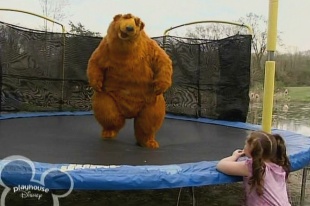 TP: Didn’t Bear jump on a trampoline in one of those?
TP: Didn’t Bear jump on a trampoline in one of those?
NM: Yes, that was the very first one. In the spirit of Snuffy and Big Bird, jumping on a trampoline. Of course I did it as me first, and let me tell you, it’s not easy jumping on a trampoline! There’s a certain finesse. So then we tried to do it, which is why you have a great shot of Bear falling over, and then the insert shots of just his head coming up and down.
TP: When was the last time you performed Bear?
NM: On the Jerry Lewis telethon in 2006.
TP: So you have a new book out, 10-Minute Puppets. How did you come up with the idea?
NM: The idea was my wife’s. I credit her every single time: This was my wife’s idea. She said, “You know two things really well. You know how to be a puppeteer, and you know how to be a dad. Why don’t you put something together where people can make puppets really simply?” I was making stuff for my son all the time. But she said, “Don’t make it crafty. Make it for people like me. You are not married to Martha Stewart.” So this is a book where it’s very, very simple. Not simple in a patronizing way, but simple in execution. It’s really not this huge mystery to make a puppet.
I also wanted to reintroduce the whole artistry and the concept of puppets to people, with a little bit of history, which is why I make references to Señor Wences, and Burr Tillstrom, and of course Jim. I asked people to contribute to the book, so I got quotes and anecdotes from Frank Oz, and Jerry Nelson, who wrote the forward, and Fran. And even other puppet people like John Tartaglia and Victor Yerrid from Sid the Science Kid. Pam Arciero, who’s Grundgetta but also the director of the O’Neil Puppetry Conferencel. And my buddy Paul McGinnis, who’s the best tabletop puppeteer around. I asked all these people to give their anecdotes about what puppetry means to them, and why it’s so magical, and to give us tips about telling a story, and character, and manipulation, and so that’s what they do throughout the book. Just to help people along, and to de-mystify it. It’s really not this hard.
In fact, one of the highlights of this past trip — I did three cities in three days, which was crazy! — I was in L.A. literally for eight hours, landed, did the gig, flew to Seattle. For that L.A. appearance at this bookstore, I showed kids how you can make a puppet. I literally took an old glove and eyes and a piece of fur, and suddenly it’s a spider. The kids said, “It’s magic!” I said, “Yes, it is! But the cool part is, it’s magic that you know how to do now, so you can do this magic yourself.” It’s moments like that that make me think, Oh good, this is working.
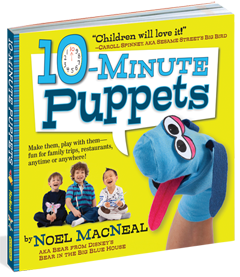 I have people do the technique that I do when I have people that I train: Lift your hand, bend your forefingers down so they’re nice and straight, put your thumb underneath. And I say, “There. This is Elmo naked.” There’s usually one or two kids that go, “Ewwww!” Then I tell them you just want to move your thumb, ’cause that’s your jaw. You don’t want to move the top part, ’cause that’s where the eyes are, because in real life — and everyone laughs — we don’t TAAALK-LIIIKE-THIIIS. People suddenly start trying to adjust their thumb, and just adding to it, putting Mr. Potato Head eyes on, and things like that. Then we have templates in the back that people can just cut out, and if they run out, they can go to my website and download more. We just want to make it as easy as possible for people to do this, to reintroduce this to a whole generation and not just take it for granted. In these interviews I’ve been calling puppetry “the original 3-D animation.”
I have people do the technique that I do when I have people that I train: Lift your hand, bend your forefingers down so they’re nice and straight, put your thumb underneath. And I say, “There. This is Elmo naked.” There’s usually one or two kids that go, “Ewwww!” Then I tell them you just want to move your thumb, ’cause that’s your jaw. You don’t want to move the top part, ’cause that’s where the eyes are, because in real life — and everyone laughs — we don’t TAAALK-LIIIKE-THIIIS. People suddenly start trying to adjust their thumb, and just adding to it, putting Mr. Potato Head eyes on, and things like that. Then we have templates in the back that people can just cut out, and if they run out, they can go to my website and download more. We just want to make it as easy as possible for people to do this, to reintroduce this to a whole generation and not just take it for granted. In these interviews I’ve been calling puppetry “the original 3-D animation.”
TP: So it sounds like it would be a good book even for people who don’t have kids, who are interest in puppetry or just getting started.
NM: Yeah, exactly. And one thing I wanted is to have kids throughout the book. Because so many puppet books just have the projects, and then maybe you’ll have a kid at the very end, holding up the puppet — that they didn’t make — and not even performing it! Just holding it up for the picture: “TA-DA! Okay, great.” So in my book, you actually see that kids are actually doing stuff. I’m proud to say my son is on the cover. He’s the one in the middle. And he’s come with me for a couple of appearances and assisted me, showing people how to do puppetry. That was one of the main things, that it’s made for kids and their grown-ups, so with these pictures of the kids you can see that it’s really easy.
I’ve done bookstore appearances, I’ve done kid museums, I’ve done a couple of schools here in New York. I actually found out that I’m going to go to my old school in Central Harlem this spring and teach kids how to make puppets in order to give back. Especially since my last day of school, there was this great puppet book in the school library, so when we got dismissed, I went to the library, found the book, put it in my bag, and just walked out.
TP: Whoa. Do you still have it?
NM: Yes, I do.
TP: Are you going to give it back?
NM: No. (laughs) But they are donating a copy of my book to the library! So it’s giving back now. Who knows, maybe someday some kid will steal my book!
TP: It sounds like the response has been good so far.
NM: Yeah, it’s been really good. In fact, this chain of stores called Michael’s, which is a craft store, ordered this huge order of books, and it’ll be available as of April 1st. So hopefully I can do some appearances at Michael’s. So if you’re reading, call your local Michael’s, and say you want me to come!
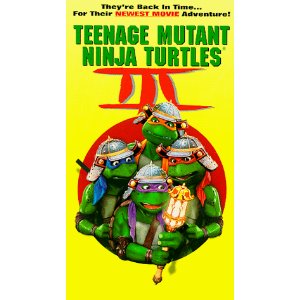 TP: If we can talk about some of your non-Muppet credits…You worked on the third Ninja Turtles movie, as Raphael?
TP: If we can talk about some of your non-Muppet credits…You worked on the third Ninja Turtles movie, as Raphael?
NM: Yes. I got recommended for it by Jim Martin, who worked on it. It was me, Jim Martin, Rick Lyon, and Gordy Robertson. We were the four. So I got recommended for the part, it was like, “Do you want to work on this,” and it was like, “Sure! Why not?” So that was like three months in Oregon, 1992, and it was great. And it takes five people to do one turtle.
TP: What was your specific role?
NM: I did the face. And Matt Hill, who is a voiceover artist now on a lot of cartoons, he was inside, so he wore the face and we would choreograph and work out things for Raph to do and for Raph to say, and so…it was fun.
TP: So how did that work — did you have a track that you were lip-synching to, or did the voice come later?
NM: No, the voice came later. They were going by what we did, which was nice. So pretty much, I had a microphone, Matt could hear me, and he could do all the body movements that he wanted to, and then I would do all the facial movements, with what I call the “glorified oven mitt.”
TP: So you were technically the voice of Raphael until post-production.
NM: Yeah, exactly.
TP: Do you try to do a character voice in a case like that?
NM: No, I just sort of do a characteristic voice, like an older brother kind of voice.
TP: You were on 30 Rock recently.
NM: Yes, me and Peter Linz. We were a peacock. Jack inherits a peacock, and so there was this peacock puppet from this company in L.A. that actually makes realistic animal puppets. We actually had to slow our actions down, because they had a real peacock there, and this peacock was so old and so docile, it just stood there. It barely moved at all. So there really wasn’t a lot we could do. So that’s why we just had to really make it simple. But it was fun being there.
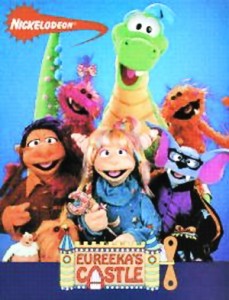 TP: I think we’d be remiss not to talk about Eureeka’s Castle. What were the differences between working on a show like Eureeka’s Castle and Sesame Street?
TP: I think we’d be remiss not to talk about Eureeka’s Castle. What were the differences between working on a show like Eureeka’s Castle and Sesame Street?
NM: With Eureeka, it was all puppets, no humans, kind of like Bear. So Magellan was poised on a platform, so that was my first experience with a body puppet of my own — walking around on a platform, with these slats on the side, making sure you don’t fall over. And it was my first experience being the performer of my own character like that, and that was really cool. Jim Kroupa, Cheryl Blalock, Brian Meehl, Pam Arciero, and Lynn Hippen…and the characters were great. The design of those puppets was brilliant, beautiful.
TP: How big was the Magellan puppet?
NM: It was kind of like Big Bird size, but without the legs, because you never saw Magellan’s bottom. So about the size of Big Bird.
TP: Did that make it easier, not having a lower half?
NM: I always wished he had, because I wanted to walk around, but he never did. But basically you could take the neck and the head off, and just wear the shirt, so you could rehearse with just the shirt on, this clown kind of shirt. And then the head and neck just kind of tucked in and stayed in. But again, it was the same kind of technology, where it was the monitor and the microphone, and Magellan had his hand pinned or he had a right hand. And then his tail was wild. And that was almost my first time of writing, so I got to write a lot of episodes. And that episode was like, bits, because it was all made up of bits, so I got to write a lot of stuff, so that was fun.
So, yeah. When I have appearances I tell people now, my resume is now most people’s childhood memories.
And now, as promised, a video bonus, in which Mr. MacNeal answers a few more questions, about working with Henson and Oz, his first Muppet role, and more:
Don’t forget to check out Noel MacNeal’s website for info on 10-Minute Puppets! And click here to inherit a peacock on the Tough Pigs forum!
by Ryan Roe – Ryan@ToughPigs.com
